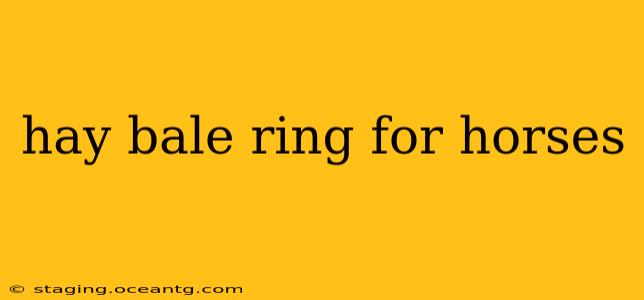Hay bale rings are a popular and practical solution for feeding horses, offering several advantages over traditional feeding methods. This comprehensive guide explores the benefits, different types available, and considerations for choosing the right hay bale ring for your equine companion. We'll also address common questions surrounding their use and safety.
What are the Benefits of Using a Hay Bale Ring for Horses?
Hay bale rings offer a multitude of benefits for both horse owners and their horses. These include:
- Reduced Hay Waste: Horses are less likely to trample or waste hay when it's fed from a ring, leading to significant cost savings over time.
- Slower Eating: The ring encourages slower eating, which is beneficial for horses prone to colic or other digestive issues. Slow feeding mimics natural grazing behavior.
- Improved Hygiene: Keeping the hay elevated and contained minimizes contamination from dirt, manure, and other debris.
- Enhanced Pasture Management: Using hay rings allows you to strategically place hay in paddocks, promoting even grazing and reducing overgrazing in specific areas.
- Convenience: Hay rings are easy to move and can be adapted to different feeding locations and needs.
What are the Different Types of Hay Bale Rings?
Several types of hay bale rings cater to various needs and budgets:
- Metal Hay Bale Rings: These are the most common type, often made from sturdy steel or other durable metals. They are available in a range of sizes to accommodate different bale sizes.
- Plastic Hay Bale Rings: While less durable than metal rings, plastic options offer lightweight portability and are often more budget-friendly. However, they may not be as resistant to damage from aggressive horses.
- Hay Bale Feeders with Rings: These combine the ring design with additional features such as a base or cover to further reduce waste and enhance functionality.
How Do I Choose the Right Size Hay Bale Ring?
The ideal size of a hay bale ring depends on the size of your hay bales and the number of horses you intend to feed from it. Always choose a ring that is appropriately sized to prevent horses from getting their heads stuck or injuring themselves. Consider the following:
- Bale Size: Ensure the ring comfortably accommodates your standard bale size without being too large or too small.
- Number of Horses: If feeding multiple horses, ensure sufficient space for each horse to access the hay without competition or overcrowding.
What are the Safety Considerations When Using Hay Bale Rings?
Safety is paramount when using hay bale rings:
- Regular Inspection: Regularly inspect the ring for damage, rust, or wear and tear. Replace any damaged rings immediately.
- Proper Placement: Place the ring in a safe location away from fences, gates, and other potential hazards.
- Secure Grounding: Ensure the ring is securely grounded to prevent it from tipping over. Consider weighting the base or using stakes.
- Supervision: While hay rings promote slower eating, always supervise horses during feeding, especially if they are prone to aggressive behavior.
What are the Best Materials for a Hay Bale Ring?
The best material for a hay bale ring depends on your priorities. Metal rings are the most durable and long-lasting, but they can be more expensive. Plastic rings are more affordable but may require replacement more frequently.
Are Hay Bale Rings Worth the Investment?
For many horse owners, the benefits of hay bale rings far outweigh the initial cost. Reduced hay waste, improved hygiene, and slower eating contribute to long-term cost savings and improved horse health.
How Do I Maintain My Hay Bale Ring?
Regular cleaning and inspection are crucial for maintaining your hay bale ring. Remove any accumulated manure, debris, or leftover hay regularly to prevent the build-up of bacteria and parasites. Inspect for damage and rust, and replace or repair as needed.
By carefully considering these factors, you can choose and utilize a hay bale ring effectively and safely, ensuring your horse benefits from a more efficient and healthy feeding system. Remember to always prioritize your horse's safety and well-being.
